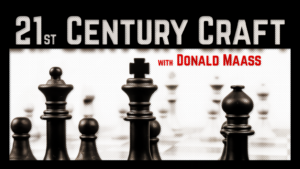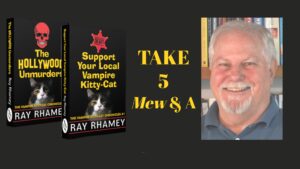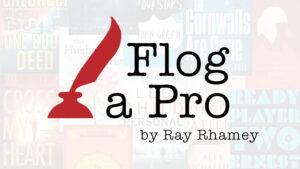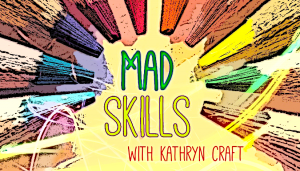CRAFT
Greetings, WU Family. In my first post of the year, I’m introducing you to Ann Michelle Harris. Ann Michelle is an attorney by day, and at night, she writes romantic suspense and fantasy/speculative fiction with diverse characters and positive social justice themes. In today’s Q&A, she shares how her work in the areas of poverty, abuse, and child welfare guides her, how that work inspired her novel, North, and why she feels building community is one of the most important things a writer can do for their career.
GW: One of my favorite parts of this series is learning about an author’s origin story: the thing that propelled you from someone who only thought about writing to someone who actually wrote and has a book out. So, what’s your author origin story—in other words, why did you start writing and keep writing?
AMH: I have loved reading adventure stories since I was very young. I was an English major at Penn so I loved not just stories but also story analysis, themes, and structure. Several years ago, I went through a stressful time in my life and began immersing myself in escapist stories as a form of comfort. After months of consuming other people’s stories, I decided to become a contributor of short stories to a public writing forum. Positive responses convinced me that I might have a larger story worth telling and that I could be brave enough to take the risk to try to tell it. I specifically wanted to write an adventure story in honor of my children. Shortly after this, the pandemic came and gave me even more stress but also much more time to write since I no longer had to spend hours commuting to the office each day (and it gave me plot inspiration). That extra time allowed me to dig deeper into creating a full manuscript and begin the process of querying.
GW: Can you tell us about your path to getting North published?
AMH: After completing my manuscript, I began to query it to a few agents and independent publishing houses. I got rejections, but one rejection from a large indie press had detailed feedback about the plot (particularly the ending) and that helped me tweak some elements. I also worked with a developmental editor, a beta reader, and a critique group to fine-tune the scene structure and build more tension in the story arc. By then, I had heard from a few writers that it is sometimes more accessible to directly find a publisher than to find an agent. I had another historical gothic manuscript that was getting a lot of traction with agents, but I decided to pitch North to a small press at a writing conference, and they loved it after reading the full story. After I signed the publishing contract, I continued to fine-tune the manuscript and then worked with the publisher for editing, galleys, and cover design. I tweaked everything until it was ready for submission to the distributor, and then finally it went into pre-order. I used my pre-launch time to promote the book online, connect with readers, and lean heavily on the wisdom of my more experienced writer colleagues, who were incredibly supportive. Then the big day came […]
Read More[Note: This post is occasioned in part by a discussion of “what to write now” begun here in January by Rachel Toalson and David Corbett.]
Last month I suggested that any work of fiction has one of two main purposes: 1) to show us what to do, or 2) to show us who we are. I like breaking fiction down into dichotomies. It clarifies things. I stand by last month’s dichotomy, and the loose association of those purposes with two types of stories, stories of fate or stories of destiny.
Another useful dichotomy is to look at fiction as having one of two effects: to cause us to fear, or to cause us to hope. It’s a spectrum. Dark to light. Horror to healing. When we understand a story’s primary purpose and intended effect, then it is easier to shape that story to give it the desired impact.
The problem, as I suggested last month, isn’t choosing one story purpose or effect over another; rather, the problem is that in many manuscripts the writer seems not to have made a strong choice in the first place. The story’s purpose is muddy. The story’s effect is soft.
I sense this especially when in manuscripts “good” and “bad” are tacitly assumed and weakly defined. We are supposed to fear something, for example, but more for its possible evil and for its scary implications. Similarly for antagonists: Bad people are signaled as bad but less often do they actually do terrible things.
Likewise hope: Good outcomes—that for which we should yearn—are assumed and unspoken, not detailed and specific. Likewise, people. Good people often are not demonstrably good but instead are presumptively good because they are victims of bad: they are put upon, powerless or in some other way, to some degree, objects of pathos.
This hazy blending of good and bad, right and wrong, weak and strong, may feel realistic to the writer, but for the reader the result is fiction of low impact. What can help? Like I said above, it starts with understanding the primary purpose—the intent—of a given story. That intent, in turn, points to the effect that you want to have on readers.
Every writer thinks that they understand the purpose of their story, and believes that the story is having a strong effect, but I rarely find that’s true. Manuscript reading doesn’t bear that out. This month, I’d like to strengthen those understandings with a longer list of primary purposes that a given story might have, which in turn will suggests ways in which to sharpen that story’s effect.
So, here we go. These are some primary purposes that I believe that any given story might have:
Which of those most strongly expresses the primary intent of your WIP? As last month, the answer “all of above” is not allowed. Choose one primary intent. Go with your gut. Choosing one primary purpose is important in counter-acting vagueness of intent and low effect, which I see […]
Read MoreAs the years go by, the average age of debut authors seems to get younger and younger. There’s plenty of reasons why this is great: the YA genre embracing authors who are the ages of their characters, the removal of societal assumptions that younger people can’t contribute to art in a meaningful way, the increase in opportunities for younger writers to access helpful resources, etc.
Conversation about this reality would stop there if two things didn’t start to emerge from this trend: 1) the publishing industry skewing notably toward younger writers to the point of sometimes completely shutting out older writers (meaning older than—gasp—30, 35 tops) for consideration for agent representation, publication, awards, or reviews, and 2) the assumption that the younger a writer publishes, the more “naturally gifted” of a writer they must be, and therefore a better writer than those who debut older.
I’ve taught plenty of creative writing courses, and nearly all my older students have expressed an identical concern: That because they’re older, they’ll be largely ignored by the industry both pre- and post-offer. Worries about age have even hit some of my younger students. On their end, they’ve been fed the assumption that since younger equals better, they must land a book deal right out of the gate. If they don’t, they’re failures, will soon be “too old” to publish in a way deemed meaningful, and they should just give up if their path to publication isn’t a breeze from beginning to end.
That’s just not how any of this works. As someone who’s publishing his debut, The Lilac People, at an apparently older age—To paraphrase a petulant Frasier Crane: I’m not yet “of a certain age,” I’m smack dab in the middle of “not a kid anymore.”—and spent over a decade collecting rejections from various projects, I want to set the record straight about the benefits of publishing older.
Read More
As I write this, I await my editor’s feedback on my new historical novel. If you want to know the truth, I’m nervous. Because, while the draft does hew closely to the outline and intentions we agreed on when I sold this book on proposal, and while I did think the draft was ready for her to assess, the waiting allows my imagination to cook up all sorts of ugly scenarios and serve them to me fresh each day. Nature abhors a vacuum, or something like that.
My nervous imagination calls me a talentless hack. It suggests I quit writing and put my creative energy into making pottery—which, it reminds me, I’ll never have to show to the public, and wouldn’t that be a nice change? There are a lot of great things about being a published novelist, but there’s also this: having one’s work publicly and perpetually reviewed and reviewable by industry, media, and ordinary readers feels similar to how I imagine it would feel to live naked in a brightly lit glass house while observers broadcast their critical assessments of my not-sculpted, middle-aged body to the world. And, as with reality, they also make critical assumptions about my intelligence, intentions, and character.
I know I should be well past these insecurities. The Voice of Good Sense says, “Dude, what’s the problem?” (It likes to call me dude; it’s retro that way.) It reminds me, “This will be your eighth published book. You’re a professional. You got this.” But here’s why confidence is easier declared than embraced: every time I write a new novel, I honestly don’t know how I’m going to do it.
Fool that some might say I am, I don’t (maybe even can’t) write the same type of book over and over again. To date, the tally is three women’s fiction, two historical fiction, two contemporary general fiction. Even within genres, my approaches vary greatly. Had I been gifted with the trait that lets some authors write, say, only mysteries, or only thrillers, or only romances, I would at least have my genre conventions as framework for every book. I might, over time, achieve something like a mastery of my form. But, no; every time, I have to figure out anew just what it is I’m trying to build, and then figure out how to go about building it. Add to this stress the fact that I’m in a new editorial relationship at a new-to-me publishing home, and the Voice of Good Sense just can’t quite drown out the Voice of Anxiety.
And yet, I’m excited about this new book (especially now that it’s finally written)! I’m excited to have tried a new form and (maybe) succeeded with it. And so, while I wait to know whether I’m more deluded in my excitement or in my anxiety, I’m going to take this opportunity to talk about the scaffolding I stood on to construct this latest book.
From the time I conceived the story, which is inspired by my own family’s history, I knew its scope was large—even “epic,” given its time setting (WW1’s chaotic aftermath in eastern Europe and the Russian Civil War) and its multiple geographical settings. I knew the story was of an arduous journey—an […]
Read MoreThe violent metaphor of writers killing their darlings has never appealed to me. I understand that we sometimes need to disrupt the comfort of our revision process, but may I suggest something a little less murderous? Tasty, even?
One of the treasured picture books of my childhood was Stone Soup. Have you read it? In this retelling of an old European fable, a hungry traveler approaches a village known for its miserly inhabitants. Desperate for food, he concocts a trick to get them to feed him. He sets up a large cauldron in the middle of the town square and fills it with water, then places a stone in the bottom of the cauldron. As it heats up, a villager comes to ask him what he’s doing.
“I’m making stone soup,” he replies, stirring the water and occasionally taking a sip. “It’s coming along nicely, but it would taste better with salt.”
The curious villager runs home and brings back some salt. By now, a crowd has gathered. The traveler seasons his soup with salt, takes another sip, and sighs. “An onion or two would be just the thing,” he says. A second villager brings an onion.
On and on it goes, with the additions of carrots, potatoes, and whatever else would go into a hearty stew. At the end, he fishes out his stone and shares a delicious meal with the no-longer hostile and selfish village. Together they’ve created stone soup.
This story delighted me on multiple levels. I loved the ingenuity of the newcomer, the gradual and piecemeal thawing of the villagers, the delicious soup that fed them all. I loved the chutzpah of fooling an entire town into thinking that a stone chucked into some boiling water could become something worth consuming.
As an adult, I still delight in the story of stone soup, but now I read it as a good metaphor for writing (isn’t everything?).
Your brain picks up a shiny bauble of an idea. It might be an interesting character, a fabulous setting, or a devilishly twisty plot. If a story in its most simplified form is simply a person, in a place, with a problem, then any of those three elements could be the stone tossed into the cauldron of your imagination.
The water comes to a boil as you go about your daily life. Soon, if your mind is at all like mine, your subconscious starts to sniff around. What’s cooking? Is it any good?
The nay-saying villagers who have colonized my mind, at least, can be a pretty suspicious bunch. They tell me that a rich and hearty story will never result from that bare rock sitting at the bottom of my pot—but they can be tricked into sharing the observations that are hidden inside the cupboards of my memory.
With a little persuasion, they open the cabinets and rummage around. Ideas, snatches of conversation, resonances from other books, and intriguing people I’ve met all add ingredients to the mix:
That guy with a scar that I saw at the bus stop? He’d make a perfect salty foil.
That snatch of conversation I overheard in the coffee shop? Unexpected zest.
That book I just finished reading, the one that tells its story in layers like an onion? I might slice it […]
Read MoreConsider this snippet of dialogue:
“What’s her name?”
“Janet.”
“I don’t feel comfortable calling anyone by their first name, especially a woman. Do you know her last name?”
“No, I don’t. You’ll just have to call her Janet, I guess.
Perfectly good, serviceable stuff, right? Clear, fairly concise, smooth. Now look at how Rex Stout actually did it in the short story “The Cop Killer:”
“What’s her name?”
“Janet.”
“I call few men, and no women, by their first names. What’s her name?”
“That’s all I know, Janet. It won’t bite you.”
The same information, but you can hear Nero and Archie in the second version. That difference is voice.
I’ve written before about how elusive voice can be. I’ve suggested possible places to look for it and covered some of the hallmarks of good dialogue. Today, let’s take a deeper dive into how it can be done.
In the example above, notice how the word choice – and the unspoken assumptions behind the word choice — fit the two characters. Nero’s love of precise language is there in the concision and precision of the parallel “few men and no women.” The exact repetition of the question, “What’s her name,” amounts to an imperious rejection of Archie’s use of the first name. And Archie’s self-possession is there in his breezy dismissal of Wolf’s rejection. Essentially, their characters and their relationship are all there in those two lines of dialogue.
Or, take another example.
Every Christmas for the last few years, I have been sharing car-related passages from some of my favorite authors on a site for old car geeks. This year’s passage, from John Jerome’s 1979 book Truck, is also one of the best examples of distinctive character voice I’ve seen. The background: in 1970, Jerome bought, for various philosophical reasons, a 1950 Dodge pickup and spent a year getting it running again. Through a combination of ignorance and mild stupidity, he destroyed a relatively obscure part – the timing chain cover — and wrote to various junkyards trying to track down a replacement. This introduced him – and us – to Armad T. Winship, a junkyard owner in Fontana, California.
You can read the entire passage here, but here are some highlights of Mr. Winship’s letter. Spelling and punctuation are as in the original.
You might not believe it but space is and always has been the problem even before Fontana got the “middle-age spread” and passed ordinances in restraint of our trade. Ten acres is all we have left, guess how may cars that will hold and Ill send you free a dimmer switch for your truck, no rust, out of the packing box, if you come with 20 of the correct number. We have a special technique for getting the most cars on the smallest lot, no its not on their sides.
*******
I . . . drove crosscountry in a 36 Plymouth in 1940 just before the War, a sweet running little car if you didn’t try to push it in the desert. Everyone had those canvas waterbags on their bumpers so the evaporation would keep it cool. We didn’t and like to died, it felt like. I asked a man in a filling station for a little […]
Read MoreThe musical Fiddler on the Roof has a poignant song, “Sunrise, Sunset,” a beautiful waltz about how quickly children grow and change.
Sunrise, sunset
Sunrise, sunset
Swiftly fly the years
One season following another
Laden with happiness and tears
Sunrise and sunset are also beginnings and endings–start and end of the day, end and start of the night, respectively. Each event a beginning and an ending at the same time. It’s difficult to tell, just by looking at a photo, whether it is a sunrise or a sunset, a start or a close.
I’ve been doing a lot of simultaneous beginnings and endings in the last month, moving into a new house and living with my boyfriend in a joint space for the first time, during the same few weeks that my father entered hospice care and then died the day after Christmas.
Both events were intense. Each one involved shedding old things to make room for the new reality. For the move, that meant figuring out what of our old lives and prior stuff we were going to keep. For my Dad, it meant ironing out legal and financial details of passing down an estate, dozens of farewell phone calls, and stripping away anything that got in his way of dying the way he wanted to. It also meant a great big, final goodbye. And the start of a new reality.
Each event got in the way of the other. If I spent time with my dad, I couldn’t unpack. And if I took time to unpack, I couldn’t spend time with my dad. Oh, the internal conflict. Of course, once it became clear that his time with us was drawing to a close, there was no more being pulled in two directions: it was all Dad all the time.
That clarity was an odd gift. There was really only one focus: helping him and our family make that transition. I remember a similar gift of clarity of purpose from the four days I took care of my cousin as she was dying. Regular life with all its competing demands was a rude shock. Is a rude shock. My ramped up anxiety at ordinary tasks and inability to concentrate tell me I’m having a hard time with these simultaneous transitions.
So. Our writing. And our poor protagonists.
So many of the things we put them through involve simultaneous beginnings and endings. Lean in to it, lean on your characters harder to highlight the push and pull. If a major event in your novel is a new beginning, throw a hard ending in there to complicate both. If a hard ending, throw in a new beginning–remembering that not everything that is new is good […]
Read MoreTrained by reading hundreds of submissions, editors and agents often make their read/not-read decision on the first page. In a customarily formatted book manuscript with chapters starting about 1/3 of the way down the page (double-spaced, 1-inch margins, 12-point type), there are 16 or 17 lines on the first page.
Here’s the question:
Would you pay good money to read the rest of the chapter? With 50 chapters in a book that costs $15, each chapter would be “worth” 30 cents.
So, before you read the excerpt, take 30 cents from your pocket or purse. When you’re done, decide what to do with those three dimes or the quarter and a nickel. It’s not much, but think of paying 30 cents for the rest of the chapter every time you sample a book’s first page. In a sense, time is money for a literary agent working her way through a raft of submissions, and she is spending that resource whenever she turns a page.
Please judge by storytelling quality, not by genre or content—some reject an opening page immediately because of genre, but that’s not a good-enough reason when the point is to analyze for storytelling strength.
How strong is the opening of this novel—would it, all on its own, hook an agent if it was submitted by an unpublished writer?
I come to town de udder night,
I hear de noise, den saw de sight,
De watchmen dey be runnin’ roun’
Cryin’ Ole Dan Tucker come to town.
Git outen de way, Git outen de way,
Git outen de way, Ole Dan Tucker,
You’s too late to come yo supper.
Sheep an’ hog a walkin’ in de pasture,
Sheep says, “Hog can’t you go no faster?”
Hush! Hush! Honey de wolf growlin’,
Ah, ah, de Lawd, bull dog growlin’,
Git outen de way, Git outen de way,
Git outen de way, Ole Dan Tucker,
You’s too late to come yo supper.
Here’s my razor in good order,
Magnum bonum-jis hab bought ’er, (snip)
Were you moved to want more?
<!–more–>
Read More
My son lives in Los Angeles, and you’ll understand that while we’ve been watching the wildfires out there with horror for those experiencing immediate loss, we’ve also had heightened concern for our son. When he called to tell us that he’d received an evacuation order from the city, he also admitted he hadn’t yet packed a bugout bag. He had no time to listen to our volley of suggestions—“Don’t forget your passport!”—he had to move.
Ironically, two months prior, while moving into a new apartment, he lost a bag filled with—in his words—“everything I’d grab in a fire.” It was excruciating for him to digest the loss of these items, which were not of the passport variety. A denim 80s Guess jacket that belonged to his dad. A painting made by a loved one. The worn skateboard that saw him through college.
Chaos on the outside can cause chaos on the inside, of course. And so after that loss, he misplaced things he never normally would have, including a credit card. His mind had been elsewhere, you might assume, though he’s also wondered—only half-jokingly—if his new apartment is home to a poltergeist.
When the fire came, it was with this additional context. He knew that what you save in a fire goes beyond practicalities like “passport” and even beyond sentimental replacements, like the new old Guess jacket we’d given him for Christmas—a replica of the one he’d lost. And only he could decide what was worth saving.
So how do you decide what’s worth saving when you have limited time and space? And what, if anything, can you deduce from this when it comes to creating characters for your novel? Is there a way you can push your characters to reveal themselves through choices forged in fire?
Choices Forged in Fire
Moments of crisis can become a powerful lens that reveals character in a way few other situations can. That’s because the pressure to choose has a way of calling everyone’s bluff—revealing core values and hidden attachments beyond the easier-to-explore surface of character. It calls the author’s bluff too, as pushing a character into the fire can illuminate for you what’s important to them.
Imagine your protagonist faced with a literal fire, given only five minutes to choose what to save. Now ask yourself:
Read More
photo adapted / Horia Varlan
The challenge for a novel’s first line is to begin orienting the reader to the story while also raising a question that inspires them to read the next line. Adding quotation marks around that sentence shines an additional spotlight that signals the reader to pay attention—”This will be important.”
That’s a lot of pressure to put on a sentence.
From the manuscripts I see in development, I suspect more writers try dialogue openings than can actually pull them off. While perusing my stacks for published examples, I set aside those that quoted only one word or name that could easily have been left off. One opened with an unremarkable question: “How was school?” (The reply: “Good.” Can you name this novel? I thought not.) In the end, only the following few dialogue openings—representing only 3% of the novels on my shelves—rose to the level of “mad skills.” Let’s see what they have to offer us.
Charlotte’s Web by E.B. White (1952)
Since I suspect middle-grade novels make use of this technique more often, I’ll start with one of the most iconic dialogue openings of all time. If you read this one when you were young, or read it aloud to your children, I’d bet you still remember its opening.
“Where’s Papa going with that ax?” said Fern to her mother as they were setting the table for breakfast.
“Out to the hoghouse,” said Mrs. Arable. “Some pigs were born last night.”
“I don’t see why he needs an ax,” said Fern, who was only eight.
While the dialogue continues a bit further, these few lines meet the demands of the opening: we are oriented to the setting and a question has been raised about a quickly devolving situation. Bonuses: stakes are suggested (the loss of a piglet’s life and a girl’s innocence), the reader is allowed to “see” more than young Fern does, and—at least among those who aren’t pig farmers—the reader is quickly infused with a sense of dread.
Ender’s Game by Orson Scott Card (1985)
The dialogue opening to this middle-grade novel sits beneath the Chapter One title, “Third.”
“I’ve watched through his eyes, I’ve listened through his ears, and I tell you he’s the one. Or at least as close as we’re going to get.”
“That’s what you said about the brother.”
“The brother tested out impossible. For other reasons. Nothing to do with his ability.”
“Same with the sister. And there are doubts about him. He’s too malleable. Too willing to submerge himself in someone else’s will.”
“Not if the other person is his enemy.”
“So what do we do? Surround him with enemies all the time?”
“If we have to.”
“I thought you said you liked this kid.”
“If the buggers get him, they’ll make me look like his favorite uncle.”
“All right. We’re saving the world after all. Take him.”
This is audacious, right? Floating voices, no named characters we can later recognize, no orientation as to where and when we are—and yet we recognize these remarks as coming from a jury of elders discussing a […]
Read MoreWhile I have earned nothing beyond a BA in English, I’ve never let that stop me from pretending I have a vast array of training and advanced degrees at my fingertips. Need a marriage therapist who’s willing to work for free? I’m your gal. Looking for a pro bono private investigator? You’ve come to the right place! Hoping to stumble upon a psychiatrist who specializes in diagnosing those who don’t know they need a diagnosis? Yep, I can do that too.
On December 24th, I found myself at Safeway, picking up the items I had forgotten to purchase on the grocery runs I had made on the 22nd and 23rd. Safeway is my go-to because I grew up shopping at Safeway. And I am a cheapskate. It’s also a little gritty, which I appreciate, because at the chichi grocery store that’s a little closer to my house, the apples are too beautiful, the specialty items too special, the shoppers too coiffed. At Safeway? I feel perfectly at home log-rolling myself from bed to car to Safeway. No coiffing required.
It was in the produce section that I found myself picking green beans from a heap and standing about fifteen feet from a couple near the potatoes. I noticed them because they appeared both too coiffed to be shopping at Safeway and too calm to be shopping on Christmas Eve. But there was something else about them that piqued my interest.
Summoning everything I learned while earning my pretend PhD in Psychology, I began my initial assessment of the couple. I guessed they were in their early 40s. She had a sassy blonde bob and wore denim trousers and a Santa hat. He was well-dressed and conventionally handsome; if you Google “generic handsome man,” you will see many iterations of him. They each wore a ring on their wedding finger. Mr. Handsome was pushing the cart.
They looked nice enough, but something was vaguely rotten in this aisle of Safeway.
Knowing I needed to move physically closer to the couple, I called on the acting skills I had learned during my pretend years at Julliard. Pretending to be checking my grocery list, then pretending I had ALMOST forgotten the onions, I pushed my cart over to the onion section. Sometimes you pretend you need a Walla Walla sweet, even if you already have onions at home, so you can eavesdrop on a couple in the nearby potato section.
And eavesdrop I did! I listened as the couple spoke of their butter lettuce options as if butter lettuce could make or break Christmas. They discussed the gift card they had purchased for his parents (at the fancy Italian restaurant down the street) and the gift card they would buy for her parents (at the fancy bakery up the street). They discussed stocking stuffers for their kids, the wrapping of gifts they needed to do that evening, the bourbon they wanted to get at the fancy liquor store. All this, while I committed, acting-wise, to finding the most perfect onion I didn’t even need.
It wasn’t the content of their conversation that felt off; it was their tentative, cautious tone and […]
Read More




















